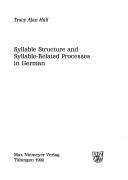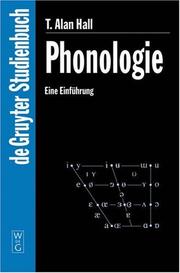| Listing 1 - 7 of 7 |
Sort by
|

ISBN: 3484302763 1306292913 3111657884 9783484302761 Year: 1992 Volume: 276 Publisher: Tübingen: Niemeyer,
Abstract | Keywords | Export | Availability | Bookmark
 Loading...
Loading...Choose an application
- Reference Manager
- EndNote
- RefWorks (Direct export to RefWorks)
Syllable Structure and Syllable-related Processes in German.
Phonetics --- German language --- Syllabication. --- Syllabication --- Ashkenazic German language --- Hochdeutsch --- Judaeo-German language (German) --- Judendeutsch language --- Judeo-German language (German) --- Jüdisch-Deutsch language --- Jüdischdeutsch language --- Germanic languages --- German language - Syllabication. --- DEUTSCHE SPRACHE --- PHONOLOGIE, PHONETIQUE ET PRONONCIATION --- MORPHOLOGIE --- PHONOLOGIE --- SYLLABE

ISBN: 3110156415 9783110156416 311080381X Year: 2000 Publisher: Berlin: de Gruyter,
Abstract | Keywords | Export | Availability | Bookmark
 Loading...
Loading...Choose an application
- Reference Manager
- EndNote
- RefWorks (Direct export to RefWorks)
Grammar, Comparative and general --- Phonology. --- 801.4 --- Fonetiek. Fonologie --- 801.4 Fonetiek. Fonologie --- Grammar, Comparative and general - Phonology.
Book
ISBN: 1283164787 9786613164780 3110215888 9783110215885 311021587X 9783110215878 Year: 2011 Publisher: Berlin: de Gruyter,
Abstract | Keywords | Export | Availability | Bookmark
 Loading...
Loading...Choose an application
- Reference Manager
- EndNote
- RefWorks (Direct export to RefWorks)
Das Studienbuch stellt auf hohem und doch allgemeinverständlichem Niveau moderne Theorien der Phonologie dar. Es richtet sich hauptsächlich an Studierende der allgemeinen und germanistischen Linguistik im Grund- und Hauptstudium, eignet sich aber auch für das Selbststudium. Die elf Kapitel widmen sich jeweils einem Bereich der Phonologie; z. B. den phonetischen Grundlagen, distinktiven Merkmalen, der autosegmentalen Phonologie, Silbenphonologie, prosodischen Phonologie und der Optimalitätstheorie. Jedes Kapitel enthält zur Vertiefung eine Reihe von Aufgaben.
Phonetics. --- Grammar, Comparative and general --- Phonology --- Articulatory phonetics --- Orthoepy --- Linguistics --- Speech --- Phonology. --- Phonologie --- --Langue allemande --- --Grammar, Comparative and general --- Philology --- Langue allemande --- Grammar, Comparative and general - Phonology --- Grammar, Comparative and general Phonology --- Linguistics.
Book
ISBN: 3961103984 9783961103980 Year: 2022 Publisher: Berlin : Language Science Press,
Abstract | Keywords | Export | Availability | Bookmark
 Loading...
Loading...Choose an application
- Reference Manager
- EndNote
- RefWorks (Direct export to RefWorks)
Velar Fronting (VF) is the name for any synchronic or diachronic phonological process shifting the velar place of articulation to the palatal region of the vocal tract. A well-known case of VF in Standard German is the rule specifying that the fricative [x] assimilates to [ç] after front segments. VF also refers to the change from velar sounds like [ɣ k g ŋ] to palatals ([ʝ c ɟ ɲ]). The book provides a thorough investigation of VF in German dialects: Data are drawn from over 300 original sources for varieties that are (or were) spoken in Germany, Austria, Switzerland, and other countries. VF differs geographically along three parameters: (A) triggers, (B) targets, and (C) outputs. VF triggers (=A) are typically defined according to vowel height: In some systems VF is induced only by high front vowels, in others by high and mid front vowels, and in yet others by high, mid, and low front vowels. Some varieties treat consonants ([r l n]) as triggers, while others do not. VF can be nonassimilatory, in which case the rule applies even in the context of back segments. In many varieties of German, VF targets (=B) consist of the two fricatives [x ɣ], but in other dialects the targets comprise [x] but not [ɣ]. In some places, VF affects not only [x ɣ], but also velar stops and the velar nasal. The output of VF (=C) is typically palatal [ç] (given the input [x]), but in many other places it is the alveolopalatal [ɕ]. A major theme is the way in which VF interacts with synchronic and diachronic changes creating or eliminating structures which can potentially undergo it or trigger it. In many dialects the relationship between velars ([x]) and palatals ([ҫ]) is transparent because velars only occur in the back vowel context and palatals only when adjacent to front sounds. In that type of system, independent processes can either feed VF (by creating additional structures which the latter can undergo), or they can bleed it (by eliminating potential structures to which VF could apply). In other dialects, VF is opaque. In one opaque system, both velars ([x]) and palatals ([ҫ]) surface in the context of front segments. Thus, in addition to expected front vowel plus palatal sequences ([ ... iç ... ]), there are also unexpected ones consisting of front vowel plus velar ([ ... ix ... ]). In a second type of opaque system, velars and palatals are found in the context of back segments; hence, expected sequences such as [ ... iç ... ] occur in addition to unexpected ones like [...ɑç...].
Book
ISBN: 9783111657882 Year: 2011 Publisher: Tübingen
Abstract | Keywords | Export | Availability | Bookmark
 Loading...
Loading...Choose an application
- Reference Manager
- EndNote
- RefWorks (Direct export to RefWorks)
Digital
ISBN: 9783111657882 9783484302761 Year: 2011 Publisher: Tübingen Max Niemeyer Verlag
Abstract | Keywords | Export | Availability | Bookmark
 Loading...
Loading...Choose an application
- Reference Manager
- EndNote
- RefWorks (Direct export to RefWorks)

ISBN: 0199267707 9780199267705 0199267715 0191708216 9780199267712 Year: 2005 Volume: 8 Publisher: Oxford: Oxford university press,
Abstract | Keywords | Export | Availability | Bookmark
 Loading...
Loading...Choose an application
- Reference Manager
- EndNote
- RefWorks (Direct export to RefWorks)
Phonetics --- Grammar --- Paradigm (Linguistics) --- Grammar, Comparative and general --- Phonology --- Phonology. --- Paradigm (Linguistics). --- Grammar, Comparative and general - Phonology
| Listing 1 - 7 of 7 |
Sort by
|

 Search
Search Feedback
Feedback About UniCat
About UniCat  Help
Help News
News